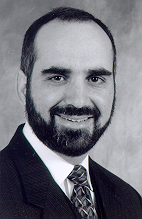|  |
Howard Gendelman, M.D. | Susan Swindells, M.D. |
“The Neurology of AIDS,” which has been called the encyclopedic text on AIDS neurology, also was edited by:
- Ian Paul Everall, M.D., professor of psychiatry at the University of California at San Diego;
- Igor Grant, M.D., professor of psychiatry and director of HIV Neurobehavioral Research Center at the University of California at San Diego; and
- Stuart A. Lipton, M.D., Ph.D., professor and scientific director, Center for Neuroscience and Aging, The Burnham Institute, La Jolla, Calif.
“Our goal is to provide a thorough understanding of the clinical manifestations of HIV neurological disease,” said Dr. Gendelman, chairman of the UNMC Department of Pharmacology and director of the Center for Neurovirology and Neurodegenerative Diseases (CNND). “We believe the advances in the textbook will aid in developing new therapies for many neurodegenerative disorders ranging from Alzheimer’s and Parkinson’s disease to amyotrophic lateral sclerosis and Huntington’s disease.”
Three years in the making, the second edition fills a void in the research literature, Dr. Gendelman said. “There needed to be a comprehensive textbook in the field and it seemed natural for us to write it taking into consideration the tremendous growth and development of our neurosciences research program,” he said. “The soul of an academic health science center is scholarly activities, and publications like this are what set you apart from others as leading the way in an important field.”
The Oxford University Press Web site agrees, proclaiming “the contributors represent some of the foremost clinical and basic science investigators in the field of NeuroAIDS worldwide.”
“The first edition of the Neurology of AIDS was a terrific textbook, but the second is even better,” said Dr. Swindells, HIV clinical medical director at UNMC. “All aspects of the problem are addressed, including chapters written by patients to highlight their perspective. The scientific chapters are all written by leaders in the field, from bench researchers to clinicians. This book contains everything that scientists, students and providers need to know about neurological complications of HIV disease.”
The “Neurology of AIDS” is a comprehensive textbook of the neurological, behavioral, motor sensory, cognitive, psychiatric and developmental aspects of AIDS, as well as a review of the basic research into HIV-1 infection of the human nervous system. Particular emphasis is placed on current thinking on disease pathogenesis, patient care and the prospects for the future. The book also features clinical perspectives from four patients, including two Nebraskans, who are living with the neurological consequences of HIV infection, as well as two community health workers who have worked with African Americans with HIV infection.
The book is unique because it comprehensively covers all aspects of the neurology of AIDS from molecular biology through clinical and patient perspectives, Dr. Everall said, noting it will serve as a single reference source for researchers and clinicians. “This second edition also provides cutting-edge information on how this disease has changed and the impact of antiretroviral treatment as well as discussing the detrimental effect of recreational drugs,” he said.
Actors and community activists Elizabeth Taylor and Sharon Stone laud the book in the foreword they co-wrote with Mathilde Krim, founding chairman and chairman of the board of the American Foundation for AIDS Research (amfAR). Taylor and Stone also are active in the organization, which is dedicated to eradicating AIDS through research.
“The Neurology of AIDS is both a well-crafted and timely offering,” writes Krim, Taylor and Stone. “The contributors are well-respected leaders in AIDS research and clinical care…It is profoundly gratifying to us to see…the publication of an updated second edition of the encyclopedic text on AIDS neurology reflecting extensive new information collected in the past half decade.”
“AIDS in the brain is a very real problem, with the prevalence of dementia due to AIDS on the rise despite better treatments for AIDS patients as a whole,” Dr. Lipton said. “The reason for this is the virus can ‘hide’ from the available drugs in the brain and cause devastation there. This book is the most comprehensive approach to this subject, taking both the scientists’ view with up-to-date information on pathogenesis and treatment of NeuroAIDS, but also displaying a more humane touch, highlighting the disease from the patients’ perspective as well.”
The first edition of “The Neurology of AIDS” was released in 1998 and received rave reviews from the New England Journal of Medicine, Journal of the American Medical Association and Journal of Neurovirology.
The revised second edition, too, will become an international resource, Dr. Grant said.
“This is a significant enhancement of the first edition, which itself was outstanding and set a standard for the field,” he said. “The fact that clinical and behavioral topics are in the same book with basic neuroscience and neurological treatises is entirely novel. It is really a mini encyclopedia, but very much state of the art. This book is sure to be a resource for researchers, clinicians and trainees of various levels, as well as a guide to policymakers regarding the latest information, and future directions in regard to the neuroscience and neurobehavioral aspects of HIV.”
